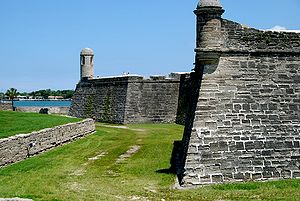| Siege of St. Augustine | |||||||
|---|---|---|---|---|---|---|---|
 Castillo de San Marcos | |||||||
| |||||||
| Belligerents | |||||||
|
|
| ||||||
| Commanders and leaders | |||||||
|
General James Oglethorpe Ahaya the Cowkeeper Commodore Pearce | Governor Manuel de Montiano | ||||||
| Strength | |||||||
|
Land forces: 1,000 infantry and militia, 900 sailors, 1,200 warriors[1][2] 56 artillery pieces Sea forces: 5 frigates, 3 sloops[3] |
Land forces: 750 infantry, 50 artillery pieces, 1 fort Sea forces : 6 small sail | ||||||
| Casualties and losses | |||||||
|
122 dead, 16 prisoners, 14 deserters,[4] 56 artillery pieces captured, 1 schooner captured | unknown | ||||||
| ||||||||
The Siege of St. Augustine was a military engagement that took place during June - July 1740. It was a part of the much larger conflict known as the War of Jenkins' Ear, between Great Britain and Spain.
Background[]
After some mutual minor skirmishes, Governor James Oglethorpe of the colony of Georgia raised a mixed force of British regulars (the 42nd Regiment of Foot), colonial militia from the Province of Georgia and the Carolinas, and native American Creek and Chickasaw, or Uchees. The campaign began in December 1739, and by January Oglethorpe was raiding Spanish forts west of St. Augustine. In May 1740, Oglethorpe undertook an expedition to capture St. Augustine itself. In support of that objective, Oglethorpe first captured Fort San Diego, Fort Picolotta and Fort Mose, the first free black settlement in America.[5]
Siege[]
Oglethorpe deployed his batteries on the island of Santa Anastasia while a British naval squadron blockaded the port. On June 24, Oglethorpe began a 27 day bombardment. On June 26, a sortie by 300[6] Spanish and free blacks attacked Fort Mose held by 120 Highlander Rangers and 30 Indians. In the Siege of Fort Mose, the garrison was taken by surprise with 68 killed and 34 captured while the Spanish loss was 10 killed.[7] The Spanish managed to send supply ships through the Royal Navy blockade and any hope of starving St. Augustine into capitulation was lost. Oglethorpe now planned to storm the fortress by land while the navy ships attacked the Spanish ships and half-galleys in the harbor. Commodore Pearce, however resolved to forgo the attack during hurricane season. Oglethorpe gave up the siege and returned to Georgia; abandoning his artillery during his withdrawal.
References[]
- ↑ Accounts vary considerably from 900 to 2,000 with the number of Indians especially at variance from 100 to 1100.
- ↑ Letter of Governor Montiano to the Governor of Cuba, 28 July 1740
- ↑ Robert Beatson, Naval and Military Memoirs of Great Britain, from 1727 to 1783, London, 1804, p.20
- ↑ David Marley, Wars of the Americas: a chronology of armed conflict in the New World, 1492 to the present. ABC-CLIO. ISBN 978-0-87436-837-6, p. 255
- ↑ Black soldiers aided in the defeat of a British attack on St. Augustine in 1728, a grateful Governor Montiano abolished slavery in Florida.
- ↑ Letter of Governor Montiano to the Governor of Cuba, 6 July 1740; Collection of the Georgia Historical Society. This letter also contains detailed and accurate intelligence from English prisoners about the large fleet and expedition that will be sent to Admiral Vernon for the attack on Cartagena de Indias: "consisting of 30 ships of the line and of a landing party of 10,000."
- ↑ Report of the Committee Appointed by the General Assembly of South Carolina in 1740. On the St. Augustine Expedition under General Oglethorpe. Published by the South Carolina Historical Society. (Charleston, S.C. : Walker, Evans & Cogswell Co., Printers, Nos. 3 and 5 Broad and 117 East Bay Streets, 1887.) Extract No. 32Deposition of Thomas Jones, survivor of the Battle of Fort Mose. His account naturally varies with that of Montiano.
See also[]

Oglethorpe Greeting the Highlanders of Darien, the 42nd Regiment of Foot (old)
- List of conflicts in the United States
- Battle of Bloody Marsh
- Battle of Gully Hole Creek
- Battle of Cartagena de Indias
- Invasion of Georgia (1742)
- Robert Jenkins (master mariner)
- The Oglethorpe Plan
The original article can be found at Siege of St. Augustine (1740) and the edit history here.
